Search the Special Collections and Archives Portal
Search Results
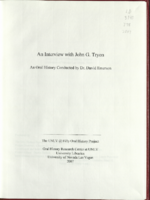
Transcript of interview with John G. Tryon by Dr. David Emerson, February 21, 2006
Date
2006-02-21
Archival Collection
Description
John G. Tryon was one of the early leading figures in the Engineering Department at UNLV. He grew up in Washington, D.C., the oldest of three sons. His father worked with the National Bituminous Coal Commission during the Depression and his mother was editor of the American Association of University Women's Publications. John went directly to University of Minnesota after high school graduation and earned a bachelor's in physics. During WWII he served in the Army Signal Corps and then went back to Cornell University to get his doctorate. His post doctoral work experience includes six years at Bell Telephone Laboratories, eleven years at University of Alaska, and six years at Tuskegee Institute. In 1974, Dr. Tryon interviewed at UNLV and was hired. The faculty carefully built up the curriculum, adding classes one at a time. John introduced a senior engineering design course modeled after one that pioneered at Dartmouth. He had also introduced this particular course at University of Alaska and Tuskegee. John was a member of the Academic Standards Committee at UNLV which helped set standards for academic probation and semester length. He has strong opinions on keeping engineering students who show promise and interest, and letting go of students whose academic strengths don't match the program. He believes students need to be matched to opportunity, be given the chance to find a niche that fits, and that they should not be given inflated grades or false hope. Dr. Tryon met his wife-to-be in Ithaca, New York, while attending Cornell University. His wife's mother, who was married to a botany professor, had invited him to Sunday dinner, something she had done for a number of students. John and his wife, who eventually became an English teacher, have two sons who grew to college age while they were in Alaska. Today they enjoy their church community, their family, and their circle of friends.
Text

Transcript of interview with Jerome "Jerry" Jay Vallen by Lisa Gioia-Acres, October 2, 2007
Date
2007-10-02
Archival Collection
Description
Jerome Jerry Jay Vallen was born and grew up in Philadelphia, Pennsylvania. His father was in the restaurant business and Jerry worked for him throughout his teens and young adulthood. He and his two brothers entertained themselves during their childhood years by going to the library and reading. This was a legacy of the Depression era, when there simply wasn't any money to spare for extraneous expenses. Jerry's first jobs were bellman / assistant manager in a small hotel; auditor, and then property manager at the Pine Tree Point Club. He attended Penn State for a year (working in his dad s restaurant the whole time) and then transferred to the hotel school at Cornell University. After a stint in the armed forces during the Korean War, he returned home and used the GI bill to finish his master's degree. He started on his doctorate, but it would be 20 years before he completed it. After getting married (1950) and starting a family, Jerry and his wife Flossie realized that the restaurant business and family life did not mix well, so he decided to stay in education. Fie spent several summers at the University of Pennsylvania in their graduate school of business and in 1966, interviewed with Jerry Crawford, provost at UNLV. Jerry and his family moved out to Las Vegas in June of 1967, leaving northern New York during a blizzard and arriving four days later in southern Nevada to find tulips blooming. They decided they liked Las Vegas, found a house right away, and settled in to their new life. Jerry taught marketing in the hotel college at the beginning of his career and for several years thereafter. Boyce Phillips took the rooms division and George Bussel taught foods. Their main focus was to attract students, and they worked on making it easier tor students to transfer from out of state. Jerry also thought it was extremely important that the hotel college be independent of university administration control. Dr. Vallen has 5 or 6 books published, including 3 textbooks that he continues to update, and an oral history of the hotel college completed shortly after he retired in 1989. Today he and his wife travel and enjoy twice yearly gatherings with their family.
Text
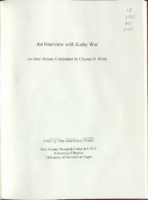
Transcript of interview with Kathy War by Claytee D. White, February 26, 2009
Date
2009-02-26
Archival Collection
Description
Kathy War fondly remembers being raised and educated in Helena, Montana. She and her husband Tom married in 1968 during an uncertain job market. After a short time in Seattle, they came to Las Vegas in 1970. Kathy drew upon her library work experience to apply for a job with UNLV's library. For the next four-and a half years she worked in the Curriculum Materials Library (CML). She then worked in the Inter-Library loan department and eventually moved to Special Collections. As she prepared to retire, she spoke of the growth that had transpired in Special Collections from three positions to ten. She describes the process of archiving over 60,00 photos and mentions the Oral History Research Center as important accomplishments of that department.
Text

Transcript of interview with Herbert C. Wells by Dr. David Emerson, March 8, 2006
Date
2006-03-08
Archival Collection
Description
Herbert C. Wells is currently professor emeritus of civil and environmental engineering at UNLV, and is considered the father of engineering at the university. He was born in Omaha, Nebraska, in 1927, and spent the first four years of his life there. After his father was killed in a plane crash in 1931, his mother moved them out to Los Angeles to be near her husband's parents. They moved several times, but the goal was always to find good schools for Herb and his sister Herb received an outstanding junior high education at Trailfinders School for Boys, and then attended Woodrow Wilson Junior High School in ninth grade. He then was sent to the San Diego Army Navy Academy, where he completed high school in two years and graduated at age 16. He next enrolled at Pasadena Junior College, majoring first in chemistry and then in geology, and was drafted into the army at age 18. After the war, Herbert returned to Berkeley to finish his education. The GI bill helped him finish his master's degree. He then went to work for United Geophysical for two years, and following that, was hired at a mine in Climax, Colorado. He and his second wife moved to Las Vegas in 1957, where he began working for Titanium Metals. After a mere three weeks on the job, he met with Dr. Malcolm Graham from early UNLV, who asked Herb to teach surveying. Dr. Wells taught surveying for only one semester, but continued his association with the faculty at the university. He kept working at Titanium Metals, where he learned a lot of practical chemistry, but was laid off shortly thereafter. He then was offered a job with Blue Diamond Gypsum as a plant engineer and continued teaching on a part-time basis. He became a full-time instructor at the college in 1961. By 1967, Herbert had been appointed chairman of science, math, and engineering. He immediately put in a request for ten more teaching positions, which were ultimately filled. He also was instrumental in putting together a proposal for a graduate degree in physics, and of course was involved in ABET accreditation for engineering degrees.
Text
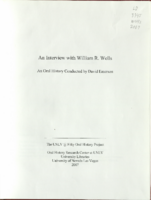
Transcript of interview with William R. Wells by David Emerson, May 22, 2006
Date
2006-05-22
Archival Collection
Description
Dr. William R. Wells was the first dean of engineering at UNLV. He was born in Winder, Georgia, and graduated from high school there. He attended Georgia Tech and then took a job with NASA in Virginia, where he also received a master's degree from Virginia Tech. He then went to Harvard for an MA degree, and ended up at Virginia Tech, earning a PhD in aerospace engineering. Dr. Wells had an impressive twenty-year work history in Ohio and Illinois before coming to UNLV in 1986. He came in on the ground floor of the newly endowed college of engineering and saw the college through several rounds of accreditation with ABET. He remembers the small student body and how easy it was for faculty members to interact with them. He also recalls that several local and state entities contributed money to the engineering program or hired graduates. As dean of the College of Engineering, Dr. Wells was involved in 'growing' the various departments. He has seen most of them develop masters and PhD programs, and remembers recruiting for new teaching positions. He also recalls moving into the new building in 1988. Accreditation was of major importance in the development of a significant and nationally recognized engineering college at UNLV, and Dr. Wells has his opinions as to its impact on creativity. He does believe that it is a necessary part of developing excellence and accountability to the community, the students and faculty, and the state. Dr. Wells talks about recruiting, faculty turnover, and salaries. He gives his opinions on using UNLV engineers for stage and set designs on the Strip, hiring graduates at local utilities, and helping students with deficient math or science skills. He also talks about attracting minority groups to engineering, diversity among the faculty, and the importance of keeping talent in the United States.
Text
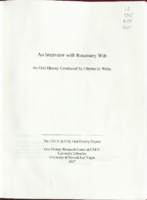
Transcript of interview with Rosemary Witt by Claytee D. White, November 7, 2006
Date
2006-11-07
Archival Collection
Description
Rosemary Witt grew up in the very small town of Columbia, Iowa. She went to a two-room country school in Columbia and attended high school in Knoxville. Her nursing diploma was completed at Iowa Methodist Hospital in Des Moines. She then worked in the operating room for a month or two and switched to pediatrics. When Rosemary's dad fell ill, she moved back to Knoxville to be closer to him and found employment at the VA psychiatric hospital. After five years there, first as staff and then as head nurse, she got the opportunity to attend a nursing program at the University of Iowa which paid tuition and a stipend. She completed her baccalaureate degree, and then worked as an assistant instructor. In the late '60s, Rosemary decided to further her education, and went to the University of Washington in Seattle for her master's in psychiatric nursing. She stayed for three years afterwards to teach on that faculty, and then attended a workshop in Las Vegas in 1971. Rosemary was attracted by the sunshine in Las Vegas, and called UNLV to see if there were any openings. She interviewed and was hired as a psychiatric nurse instructor. In '75 or '76, she decided to pursue her doctorate at the University of Texas in Austin, and persuaded her sister to move to Las Vegas to watch her house and pets while she was away at school. In the many years that she's been at UNLV, Rosemary had served as chair of the nursing program for over thirty of those years. She also served as interim director for a year while a search was conducted for a dean. Today she teaches classes and is involved in research. Rosemary recalls the early days when several disciplines were housed in Frazier Hall. Having spent over thirty years at UNLV, she has seen many changes in the campus and in the city. Today the nursing program has its own school and inhabits most of a large building. She and other instructors are involved in research which improves life for Las Vegans and patients everywhere. She is confident that the nursing school will continue to grow and offer more educational opportunities for students.
Text
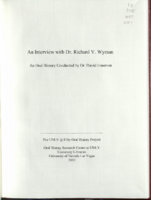
Transcript of interview with Dr. Richard V. Wyman by Dr. David Emerson, February 27, 2006
Date
2006-02-27
Archival Collection
Description
Dr. Richard V. Wyman was born in Painesville, Ohio, and lived there until he joined the navy in 1943 at the age of 17. His father got into real estate and insurance in Painesville. Richard's mother graduated from Ohio State with a degree in home economics, worked until she married, and then devoted her life to her family. In high school, Dick took college prep classes. A month before he graduated he joined the Navy and was sent to college part of the time. He got out of the Navy in 1946 and continued on in college with help from the 52-20 club, a type of GI bill. He studied geology in the night school division of Western Reserve. He met his future wife Anne during this time and they were both admitted to Michigan State grad school. After graduate school, Richard and his wife moved to South America where he had been offered a job. His wife eventually taught grade school there, K through 8. They moved back to Prescott, Arizona, where Dick was offered a job with New Jersey Zinc. Art Still then hired him to work for Western Gold and Uranium and the Golden Crown Mining Company, so Richard and Anne moved to St. George, Utah, with their son Bill. In 1959 Dick met with Don McGregor who hired him to build the Marshmallow Tunnel at the Nevada Test Site. He also built the Exchequer Tunnel for the Sunshine Mine in Idaho, and a tunnel in Merced, California. Eventually McGregor asked him to return to the Test Site to work on Project Pile Driver. In 1969 Herb Wells offered Richard a job at UNLV teaching in engineering. He taught statics, strength and materials, surveying, field mapping and geology. He later added engineering economics, engineering management, economic geology, field geology and mineralogy. Richard took a couple of terms as chair of science and engineering, sharing that responsibility with Herb Wells, Bob Skaggs, Ray Martinez, and John Tryon. The program eventually had three civil engineers and could apply to ABET for accreditation. Dick was chair at the time, motivating the faculty to gather everything they needed for the inspections. In the '80s, the Engineering Advisory Council helped the faculty develop a plan for a new engineering building. Faculty members worked with the architect to make sure those classrooms and labs had everything they needed. After moving into the new building, civil engineering forged ahead, creating a PhD program. Over the years, Dick saw the splitting up of the old College of Science, Math, and Engineering into separate disciplines and watched the number of graduates increase from 10 to between 30 and 50. After he retired from UNLV in 1992, Dick did ABET evaluations for about eight years.
Text
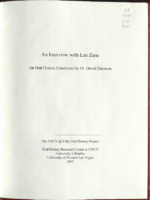
Transcript of interview with Len Zane by Dr. David Emerson, May 10, 2007
Date
2007-05-10
Archival Collection
Description
Len Zane and his wife left Colorado State to come to UNLV in 1973. He intended to take a one year position in physics which had materialized that summer, and found a department in turmoil, with a high turnover rate and scrambling to fill suddenly vacated positions. The faculty in physics at that time consisted of Harry Fector, Lon Spight, Fred Stirk, and another new hire, Dave Bynum from UNR. During that first semester, Len taught the graduate mechanics class, and found that the five or six students actually knew very little. In addition he taught modern physics and a beginning engineering physics course. Two more instructors were hired during Len's first year at UNLV, Ed Grayzak and Jeff Dundan. Len got a permanent position that first year and was no longer considered a visitor. At the end of his second year, he accepted a one year visiting position at Dartmouth, and returned to UNLV to become chair of the physics department. At almost the same time, he got tenure and was promoted to associate professor. Dr. Zane was chair of the department from 1977 to 1981, and then was asked to step down. He helped write a set of bylaws for the department that would help change of leadership go more smoothly. John Unrue approached Len around 1984 about setting up an honors program, an idea which had the full support of Robert Maxson, then president of UNLV. Len took on the challenge and helped develop curriculum and recruit faculty. He oversaw the honors program through the transition to Honors College, and served as dean of the college for 15 years, from 1985 to 2000. Dr. Zane returned to teaching in 2000, and continues in that capacity today. He has spent over 34 years in education and administration at UNLV, and has enjoyed working with great people and accomplishing personal goals.
Text

Transcript of interview with Robert, Ann, Joseph, Patrick, & David Genoves by Shirley Emerson, August 29, 2013
Date
2013-08-29
Archival Collection
Description
In 1960, the same year the original Ocean’s Eleven was filmed at the Sands Hotel and Casino, Robert “Bob” Genovese moved to Las Vegas to pursue a career in music. Bob’s band, The Jets, quickly got a gig at the Fremont Hotel, working opposite Wayne and Jerry Newton. Seven years later, Bob met and married Ann. The couple spent much of their early years of marriage on the road for Bob’s work, with Las Vegas always as their home base. A few years later they bought a home in McNeil Estates, and ceased their nomadic life when their eldest son, Joseph, started school. Over the years, Bob’s music career flourished, and he played showrooms across the valley, including Caesars Palace, the Flamingo, and the Driftwood Lounge, working opposite legends like Duke Ellington and Lionel Hampton. Bob and Ann’s personal life also thrived, and they had three sons: Joseph “Joe” Genovese, Patrick Genovese, and David Genovese. By all accounts, the children enjoyed an ideal upbringing. Neighbors watched out for neighbors, and all the children were friends, and spent equal parts getting in and out of trouble. After her sons grew up, Ann used her skills to start and run a travel agency. Joe, Pat and David have all remained in Las Vegas, and live back in their childhood neighborhood in the heart of the city. Joe is a successful land developer; Patrick worked for the City of North Las Vegas’ Parks and Recreation Division for 12 years before joining Gibson Guitars; and David has spent his career working at the Station Casinos. Following in both their father and mother’s musical footsteps, the Genovese sons formed a band as young adults and continue to play together informally. Having lived in Las Vegas for several decades, the Genoveses all have a unique and informed perspective on the growth and development of Las Vegas. They have witnessed hotels and casinos being erected and being demolished; experienced schools being segregated and then integrated; and seen the city transition from mob-run to corporate-dominated. The family remains committed their community, and being a part of its renaissance to ensure that it is still a great place to be a local.
Text

Transcript of interview with Barbara Buckley, Kevin Buckley, Michael Buckley, Jill Buckley, and Lindsay Stilwell by Claytee D. White, January 28, 2014
Date
2014-01-28
Archival Collection
Description
Kevin: Stories about the early Pinto Palomino neighborhood, work as a teenager, black-white relations, schooling including Bishop Gorman, and the move to Las Vegas. Barbara: Difference between Flintridge, CA, and Las Vegas in 1968 when the family arrived. Husband served as one of the doctors of Howard Hughes. Community participation and hotel-casino entertainment for young couples, rearing children in Las Vegas.
Text
Pagination
Refine my results
Content Type
Creator or Contributor
Subject
Archival Collection
Digital Project
Resource Type
Year
Material Type
Place
Language
Records Classification
